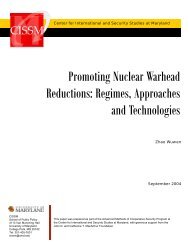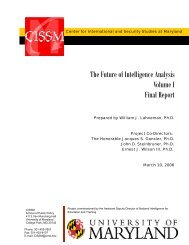A Reassurance-Based Approach to Space Security - Center for ...
A Reassurance-Based Approach to Space Security - Center for ...
A Reassurance-Based Approach to Space Security - Center for ...
- No tags were found...
Create successful ePaper yourself
Turn your PDF publications into a flip-book with our unique Google optimized e-Paper software.
In space, the situation is much murkier. In addition <strong>to</strong> classical conceptions of spaceweapons—as dedicated anti-satellite weapons, space-based weapons that can hit terrestrialtargets, or space-based missile defense intercep<strong>to</strong>rs—some space capabilities are dual-useand can be used in anti-satellite mode or <strong>for</strong> other purposes. An exoatmospheric missiledefense intercep<strong>to</strong>r, <strong>for</strong> example, could destroy a satellite circling Earth in a predictable orbitmore easily than it could s<strong>to</strong>p a ballistic missile suddenly launched at an unanticipated target.Low-powered, commercially available lasers used <strong>for</strong> satellite tracking and other legitimatepurposes could temporarily blind imaging satellites. 33 And small, maneuverable satellitescould conduct close proximity operations <strong>for</strong> benign reasons, such as taking diagnosticpictures of a malfunctioning satellite, or <strong>for</strong> malicious ones. There is no way <strong>to</strong> outlaw allcapabilities that could be used as space weapons without also <strong>for</strong>egoing many beneficialapplications.Uncertainty about a satellite’s function is as much of a problem <strong>for</strong> soft law as it is<strong>for</strong> <strong>for</strong>mal arms control. Commercial space-based communication and imaging services areused extensively by the United States and increasingly by other countries <strong>to</strong> enhance theirterrestrial military capabilities. In addition, governmental and non-governmental satellites canserve users from different countries, making it hard <strong>to</strong> determine when and what type ofaction against a satellite would be acceptable under international laws of armed conduct,including principles of necessity, proportionality, discrimination, and neutrality.Instead of posing insurmountable barriers <strong>to</strong> arms control, these conceptualcomplications present compelling reasons <strong>for</strong> regulating behavior and not just capability (i.e.,whether a technology fits criteria that define it as a “weapon” or that are used as a proxy <strong>for</strong>hostile intent). They suggest that trying <strong>to</strong> find the right balance between protecting peacefuluses of space and preventing aggressive, unacceptably threatening, or recklessly irresponsibleones, should be done through a discussion and negotiation process that includes all keystakeholders and is approached as an evolving and interactive project, rather than as anabstract intellectual exercise, a policy question <strong>to</strong> be answered separately by each space-faringstate, or a static course of action where the rules, once negotiated, are set in s<strong>to</strong>ne. Perhapsmost importantly, these complexities suggest that be<strong>for</strong>e trying <strong>to</strong> elaborate new rules <strong>for</strong>cooperative space security, parties need <strong>to</strong> decide on the fundamental purpose and guidingprinciple of their enhanced space security regime.33 Low-powered laser beams are sent in<strong>to</strong> space hundreds of times a year <strong>for</strong> various reasons, including trackingand imaging satellites, measuring distances between objects in space, calibrating instruments, and assessingcontinental drift. In 1997, the United States used high- and low-powered lasers against one of its own satellites<strong>to</strong> assess vulnerability <strong>to</strong> deliberate attacks and <strong>to</strong> the level of inadvertent lasing that might occur if a satellitecrossed in<strong>to</strong> one of these low-powered beams. For technical reasons, the United States could not collectcomplete in<strong>for</strong>mation on the effects of the high-powered MIRACL laser, but it did determine that the 30 watttracking laser, used longer than intended because of in<strong>for</strong>mation collection problems, was sufficient <strong>to</strong> dazzlethe imaging satellite at 500 km altitude. For an assessment of what can and cannot be done with low-poweredlasers, see Wright, Grego, and Gronlund, The Physics of <strong>Space</strong> <strong>Security</strong>, pp. 125-128. Kenneth Bacon, “DoD NewsBriefing,” Oc<strong>to</strong>ber 23, 1997, http://www.defenselink.mil/transcripts/transcript.aspx?transcriptid=1103describes the MIRACL laser test.22







